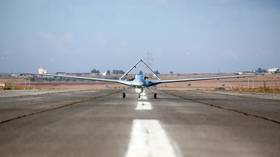MOMENT massive Arecibo telescope collapsed caught in jaw-dropping footage
Newly released footage shows the dramatic final moments of the Arecibo Observatory – the second-largest radio telescope on Earth – which collapsed earlier this week, in yet another major loss for humanity in 2020.
On Tuesday morning at 7.54 am local time, the 900-ton platform at the Arecibo Observatory, which sent and detected radio waves to and from outer space, fell 450 feet (140 meters) and crashed into the 1,000-foot-wide (300-metre-wide) disk below.
Its auxiliary support cables had snapped in August and November, before the final, catastrophic structural failure on Tuesday, when the cables connecting the hanging platform also gave way, pulling down the tops of nearby supporting towers.
Jonathan Friedman, a member of the observatory’s staff, said the collapse sounded like an earthquake or an avalanche. Footage from the scene, captured by one of the control towers, appears to support his assessment.
@NSF just shared video footage of the Arecibo telescope's catastrophic collapse Tuesday morning. It's loud.(Courtesy of the Arecibo Observatory, an NSF facility) pic.twitter.com/9zvyrUsfJl
— Morgan McFall-Johnsen (@MorganMJohnsen) December 3, 2020
“As you can see, this was a very violent and kind of unpredictable failure,” Bevin Ashley Zauderer, the National Science Foundation (NSF) program manager for the Arecibo Observatory, told journalists in a briefing on Thursday.
Engineers involved in the deconstruction plans were conducting a remote risk assessment, and inspecting the supporting cables using a drone, at the time of the collapse.
No one had been allowed to approach the structure since mid-November due to the unknown timeline of the impending doom. There were no injuries sustained in the collapse as a result of these precautions.
In 1974, Arecibo sent the Earth’s most powerful broadcast, to see if any aliens might answer the call. It never heard back.
Tuesday’s incident will now greatly curtail humanity’s search for radio waves sent by other lifeforms in the universe, as it will effectively halve our monitoring of such signals coming from outer space.
Also on rt.com World’s most powerful radio telescope COLLAPSES in Puerto Rico, after decades of hunting alien signals from space (PHOTOS)China’s Five-hundred-meter Aperture Spherical Radio Telescope (FAST) and Arecibo were widely viewed as Earth’s ‘two big eyes,’ and were specifically tasked with monitoring these signals on a 24-hour basis, given their locations on opposite sides of the planet. The Chinese facility will now bear the brunt of monitoring responsibilities until a suitable replacement is constructed.
“If you are monitoring a source of interest which is in the weak radio spectrum, you need two big radio telescopes: one pointing toward something during the day and the other through the nighttime,” said Abel Méndez, director of the Planetary Habitability Laboratory at the University of Puerto Rico at Arecibo.
Other smaller facilities can pick up some of the slack, but are not as sensitive to weaker signals as the Arecibo was.
In a somewhat surprising revelation, Ralph Gaume, director of the NSF’s division of astronomical sciences, said, “The NSF is not closing the Arecibo Observatory,” adding that it was too early to discuss plans for replacing the facility.
Think your friends would be interested? Share this story!













